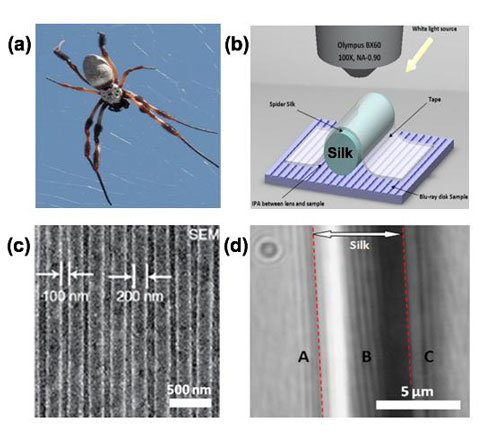| Posted: Aug 19, 2016 |
Using spider-silk as a superlens to increase a microscope's potential
(Nanowerk News) Scientists at the UK's Bangor and Oxford universities have achieved a world first: using spider-silk as a superlens to increase the microscope's potential.
|
|
Extending the limit of classical microscope's resolution has been the 'El Dorado' or 'Holy Grail' of microscopy for over a century. Physical laws of light make it impossible to view objects smaller than 200 nm - the smallest size of bacteria, using a normal microscope alone. However, superlenses which enable us to see beyond the current magnification have been the goal since the turn of the millennium.
|
|
Hot on the heels of a paper ("Visible light superlens made from nanobeads") revealing that a team at Bangor University's School of Electronic Engineering has used a nanobead-derived superlens to break the perceived resolution barrier, the same team has achieved another world first.
|
|
Now the team, led by Dr Zengbo Wang and in colloboration with Prof. Fritz Vollrath's silk group at Oxford University's Department of Zoology, has used a naturally occurring material - dragline silk of the golden web spider, as an additional superlens, applied to the surface of the material to be viewed, to provide an additional 2-3 times magnification.
|
|
This is the first time that a naturally occurring biological material has been used as a superlens.
|
|
In the paper in Nano Letters ("Spider Silk: Mother Nature’s Bio-Superlens"), the joint team reveals how they used a cylindrical piece of spider silk from the thumb sized Nephila spider as a lens.
|
 |
| a) Nephila edulis spider in its web. (b) Schematic drawing of reflection mode silk biosuperlens imaging. The spider silk was placed directly on top of the sample surface by using a soft tape, which magnify underlying nano objects 2-3 times (c) SEM image of Blu-ray disk with 200/100 nm groove and lines (d) Clear magnified image (2.1x) of Blu-ray disk under spider silk superlens. (Image: Bangor University/ University of Oxford)
|
|
Dr Zengbo Wang said: "We have proved that the resolution barrier of microscope can be broken using a superlens, but production of manufactured superlenses invovles some complex engineering processes which are not widely accessible to other reserchers. This is why we have been interested in looking for a naturally occurring superlens provided by 'Mother Nature', which may exist around us, so that everyone can access superlenses."
|
|
Prof Fritz Vollrath adds: "It is very exciting to find yet another cutting edge and totally novel use for a spider silk, which we have been studying for over two decades in my laboratory."
|
|
These lenses could be used for seeing and viewing previously 'invisible' structures, including engineered nano-structures and biological micro-structures as well as, potentially, native germs and viruses.
|
|
The natural cylindrical structure at a micron- and submicron-scale make silks ideal candidates, in this case, the individual filaments had diameters of one tenth of a thin human hair.
|
|
The spider filament enabled the group to view details on a micro-chip and a blue- ray disk which would be invisible using the unmodified optical microscope.
|
|
In much the same was as when you look through a cylindrical glass or bottle, the clearest image only runs along the narrow strip directly opposite your line of vision, or resting on the surface being viewed, the single filament provides a one dimensional viewing image along its length.
|
|
Wang explains: "The cylindrical silk lens has advantages in the larger field-of-view when compared to a microsphere superlens. Importantly for potential commercial applications, a spider silk nanoscope would be robust and economical, which in turn could provide excellent manufacturing platforms for a wide range of applications." |
|
James Monks, a co-author on the paper comments: "it has been an exciting time to be able to develop this project as part of my honours degree in electronic engineering at Bangor University and I am now very much looking forward to joining Dr Wang's team as a PhD student in nano-photonics."
|

